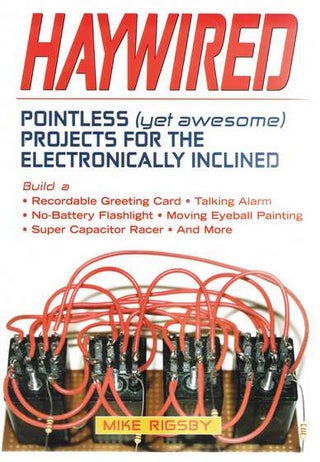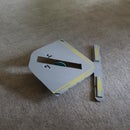Introduction: Flashlight Without Batteries--from the Book, "Haywired"
In this project, you will make a flashlight that works without batteries. Even more amazing, you can recharge it in three minutes and it will run for more than 24 hours. Because the ultra capacitors can be recharged thousands of times, you may save the environment from ever receiving an old flashlight in the trash system.
This project is from my book Haywired

Click here to order a copy from the Chicago Review Press.
Parts List
(2) 220 farad capacitors, www.digikey.com, #589-1013-nd
Insulated wire, black and red
Solder
LED, high brightness, www.jameco.com, #217525
12" x 12" acrylic plastic sheet, 1/8" thick
Permanent marker
(2) C clamps
Epoxy
1/4" jack, Radio Shack, #374-280
Metallic tape
SPST rocker switch, Radio Shack, #275-693
Glue
Electrical Tape
Tools List
Wire cutters
Soldering Iron
Scoring knife (for plastic)
Single-hole paper punch
3-volt DC power supply--700 milliamp
Drill
1/4", 1/16", and 3/4" drill bits
Metal straightedge
This project is from my book Haywired

Click here to order a copy from the Chicago Review Press.
Parts List
(2) 220 farad capacitors, www.digikey.com, #589-1013-nd
Insulated wire, black and red
Solder
LED, high brightness, www.jameco.com, #217525
12" x 12" acrylic plastic sheet, 1/8" thick
Permanent marker
(2) C clamps
Epoxy
1/4" jack, Radio Shack, #374-280
Metallic tape
SPST rocker switch, Radio Shack, #275-693
Glue
Electrical Tape
Tools List
Wire cutters
Soldering Iron
Scoring knife (for plastic)
Single-hole paper punch
3-volt DC power supply--700 milliamp
Drill
1/4", 1/16", and 3/4" drill bits
Metal straightedge
Step 1: Put Capacitors in Series
First, solder a wire from the (+) on one capacitor to the (-) on the other capacitor.
Step 2: Solder Wire to (+)
Solder a 4-inch length of red wire to the unused (+) terminal on the capacitor. You will call this capacitor wire (+).
Step 3: Solder Wire to (-).
Solder a 2-inch length of black wire to the unused (-) terminal on the capacitor. You will call this capacitor wire (-).
Step 4: Correct Method to Cut Plastic
Next cut the 1/8-inch plastic sheet for the flashlight case. Generally, this is accomplished by scoring the plastic, then breaking it along scored lines. But first, mark the plastic with a marker, then use the C clamp to hold a metal straight-edge next to the mark. Then use the tip of a scoring knife (usually sold next to the plastic sheets) to create a fine groove in the plastic along the line you marked.
Step 5: Scoring Plastic
Using the scoring edge (not the knife tip) pull the knife along the fine line several times until you create a groove. The plastic can now be snapped along the score line. Practice this method a few times until you master the technique.
Step 6: Start the Case
Now you're ready to build your flashlight case. First, cut out three 1 1/4 x 7 inch pieces of plastic and glue them together with epoxy. This is the flashlight body.
Step 7: Install Jack
Cut a plastic piece 1 1/4 inches by 1 1/2 inches. Drill a 1/4-inch hole and insert the 1/4-inch jack. Hold the jack with one hand (to prevent it from rotating) while threading the nut and washer.
Step 8: Add Wires to Jack
Solder a 2-inch-long black wire to the end of the jack near the tab. Solder a 3-inch-long red wire to the other side of the jack (away from the tab).
Step 9: Attach Jack to Capacitor
Solder the red wire from the jack to the capacitor (+). Solder the black wire from the jack to capacitor (-). These wires form the path that will be used to charge the capacitors.
Step 10: Prepare for LED
Cut a piece of plastic, 1 x 1 1/4 inches. Drill two 1/16-inch holes in the center, side by side, the same distance apart as the leads on the LED. Cut a piece of metallic tape, 1 x 1 1/4 inches. Punch a hole in the center of this tape using a hole punch.
Step 11: Place Reflector and LED
Remove the paper backing from the tape and fasten the tape to the plastic. This is part of the reflector for the flashlight. Insert the LED leads through the holes.
Step 12: On Off Switch
Cut a piece of plastic 7 inches by 1 1/4 inches. Drill a 3/4 inch hole 2 1/4 inches from the end. This is the plastic switch holder. Press the on/off switch through the hole and secure it by threading the switch's plastic nut.
Step 13: Attach Wire to Switch
Solder one end of a 6-inch length of black wire to one end of the capacitor (-). Solder the other end to the on/off switch.
Step 14: Capacitor (+) to LED
Solder the wire from capacitor (+) to the long lead of the LED.
Step 15: LED to On/off Switch
Cut a 2-inch length of red wire. Solder one end to the short lead on the LED. Solder the other end to the on/off switch.
Step 16: Glue Jack Piece to Flashlight Body
When the switch is on, power will flow from capacitor (+) through the LED, through the switch, back to capacitor (-). This will cause the LED to light up. Carefully place the capacitors and the jack into the flashlight body. Glue the jack piece onto the end of the flashlight body.
Step 17: Separated Jack and Capacitor
Cut a 1 by 3/4 inch piece of plastic. Insert it into the flashlight body, between the jack and the capacitor. This will prevent the capacitor from sliding into the jack; thus avoiding a potential short circuit
Step 18: Cover On/off Switch Wires
Place electrical tape over the on/off switch wires.
Step 19: Glue LED Holder
Glue the LED holder into the flashlight body.
Step 20: Form Reflector
Place metallic tape inside the flashlight body and on the plastic switch holder to form the reflector.
Step 21: Finish Assembly
Glue the plastic switch holder to the flashlight body. Cut a 1 1/2 x 1 1/4 inch piece of plastic for the lens. Glue the lens in front of the LED.
Step 22: Charge and Use
Plug a 3-volt DC power supply, (+) tip, into the back for three minutes. Remove the power supply and enjoy your new flashlight.




